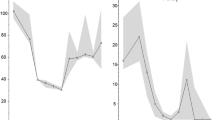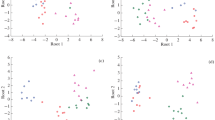Abstract
The effects of dopamine, epinephrine and norepinephrine on energy metabolism as well as intracellular pH in rat liver and brain during hemorrhagic shock were examined by in vivo31p-NMR spectroscopy. The hemorrhagic shock was induced by arterial bleeding to a mean arterial pressure (MAP) of 30–40 mmHg. Upon the induction of hemorrhagic shock, there was a dramatic fall in adenosine triphosphate (ATP) and a rise in inorganic phosphate (Pi) in the liver. The intracellular pH indicated severe acidosis. However, no change in these parameters was observed in the brain during hemorrhagic shock. After infusion of the above catechollamines following 10 min of hemorrhagic shock, MAP increased to 90–100% of its control value. Only dopamine improved hepatic energy metabolism, whereas brain evergy metabolism was not affected by any of them. This suggests that dopamine protects liver function during hemorrhagic shock without affecting brain energy metabolism.
Similar content being viewed by others
References
Shoemaker WC, Turk LN, Moore FD: Hepatic vascular response to epinephrine. Am J Phsiol 210:58–62, 1961
Turk LN, Shoewmaker WC:Hepatic vascular response to norepinephrine. Am J Physiol 206:1175–1178, 1962
Higgins CB, Millard RW, Braunwald E, Vatner SF: Effects and mechanisms of action of dopamine on regional hemodynamics in the conscious dog. Am J Physiol 225:432–437, 1973
Krarup N: The effect of noradrenaline and adrenaline on hepatosplanchnic hemodynamics, functorial capacity of the liver and hepatic metabolism. Acta Physiol Scand 87:307–319, 1973
Greenfield Jr JC, Tindall GT:Effect of norepinephrine, epinephrine, and angiotensin on blood flow in the internal carotid artery of man. J Clin Invest 47:1672–1684, 1968
Essen C: Effects of dopamine on the cerebral blood flow in the dog. Acta Neurol Scand 50:39–52, 1974
MacDonell L, Xanalatos C, Hall S, James 1M: Factors affecting the response of cerebral metabolism and blood flow to a noradrenaline infusion in the dog. Europ Neurol 6:208–212, 1971/72
Ekstrom-Jodal B, Essen C, Haggendal E: Effects of noradrenaline on the cerebral blood flow in the dog. Acta Neurol Scand 50:11–26, 1974
Olesen J: The effect of intracarotid epinephrine, norepinephrine, and angiotensin on the regional cerebral blood flow in man. Neurology 22:978–987, 1972
Radda GK, Seeley PJ:Recent studies on cellular metabolism by nuclear magnetic resonance. A Rev Physiol 41:749–769, 1979
Gadian DG, Radda GK:NMR studies of tissue metabolism. An Rev Biochem 50:69–83, 1981
Malloy CR, Cunningham CC, Radda GK: The metabolic state of the liver in vivo measured by31P-NMR spectroscopy. Biochim Biophys Acta 885:1–11, 1986
Roberts JKM, Wade-Jardetzky N, Jardetzky O: Intracellular pH measurements by31P nuclear magnetic resonance. Influence of factors other than pH on31P chemical shifts. Biochemistry 20:5389–5394, 1981
Seo, Y, Murakami Y, Watari H, Imai Y, Yoshizaki K, Nishikawa H, Morimoto T: Intracellular pH determination by a31P-NMR technique. The second dissociation constant of phosphoric acid in a biological system. J Biochem 94:729–734, 1983
Krarup N: The effect of hemorrhage on hepatosplanchinic hemodynamics, liver function and hepatic metabolism. Acta Physiol Scand 89:269–277, 1973
Greenway CV, Lawson AE, Stark RD: The effect of hemorrhage on hepatic artery and portal verin flows in the anaesthetized cat. J Physiol 193:375–379, 1967
Muller, W, Smith LL: Hepatic arterial and portal venous circulatory changes following acute hemorrhage in the dog. Surg Gynecol Obstet 117:753–758, 1963
Frank ED, Frank HA, Jacob SW, Jacob F: Hepatic blood flow in the expermental hemorrohagic shock. Am J Physiol 202:711, 1962
Hanson KM, Johnson PC: Local control of hepatic arterial and portal venous flow in the dog. Am J Physiol 211:712–720, 1966
Kamiike W, Watanabe F, Hashimoto T, Togawa K, Ikeda Y, Nakao K, Kawashima Y: Changes in cellular levels of ATP and its catabolites in ischemic rat liver. J Biochem 91:1349–1356, 1982
Kaasik AE, Nilsson L, Siesjo BK: The effect of arterial hypotension upon the lactate, pyruvate and bicarbonate concentrations of brain tissue and cisternal CSF, and upon the tissue concentrations of phosphocreatine and adenine nucleotides in anesthetized rats. Acta Physiol Scand 78:448–458, 1970
Brierley JB, Brown AW, Excell BJ. Meldrum BS: Brain damage in the rhesus monkey resulting from profound arterial hypotension. I. Its nature, distribution and general physiological correlates. Brain Res 13:68–100, 1969
Robie NW, Goldberg LI: Comparative systemic and regional hemodynamic effects of dopamine and dobutamine. Am Heart J 90:340–345, 1975
Hagino Y Nakashima M: Adrenergic receptors in rat liver II. Effects of phynylephrine, isoproterenol and adrenergic blocking agents on gluconeogenesis in perfused liver. Japan J Pharmacol 24:373–381, 1974
Ross G, Kurrasch M: Adrenergic responses of the hepatic circulation. Am J Physiol 216:1380–1385, 1969
Geumi A, Mahfauz M: The presence of-adrenergic receptors in the hepatic vasculature. Brit J Pharmacol Chemotherap 32:446–472, 1968
Hanson KM: Response of intrahepatic vasculature to isoproterenol and epinephrine infusions. Angiologica 10:65–75, 1973
Goldberg LI: The dopamine vascular receptor. Biochem Pharmacol 24:651–653, 1975
Yeh BK, Mac Nay JL, Goldberg LI: Attenuation of dopamine renal and mesenteric vaso-dilation by haloperidol. Evidence for a specific dopamine receptor. J Pharmacol Exptl Ther 168:303–309, 1969
Maestracci P, Grimaud D, Livrelli N, Philip F, Dolisi C: Increase in hepatic blood flow and cardiac output during dopamine infusion in man. Crit Care Med 9:14–16, 1981
Toda N: Responses of isolated cerebral and periphiral arteries to vasoconstricting agents. In neurogenic control of brain circulation. Ed. by C. Owman and L. Edvinsson, Pergamon Press, 1977, pp 207–217
Toda N, Fujita Y: Responsiveness of isolated cerebral and peripheral arteries to serotonin, norepinephrine, and transmural electrical stimulation. Circul Res 33:98–104, 1973
Rosenblum WI: Contractile response of pial arterioles to norepinephrine. Arch Neurol 31:197–199, 1974
Toda N: Heterogeneity in the response to dopamine of monkey cerebral and peripheral arteries. Am J Physiol 245:H930-H936, 1983
King BD, Sokoloff L, Wechsler RL: The effects of I-epinephrine and l-norepinephrine upon cerebral circulation and metabolism in man. J Clin Invest 31:273–279, 1952
Michenfelder JD, Theye RA: Effects of cyclopropane on canine cerebral blood flow and metabolism; modification by catecholamine suppression. Anesthesiology 37:32–39, 1972
Fazekas JF, Thomas A, Johnson JVV, Young WK: Effect of arterenol (norepinephrine) and epinephrine on cerebral hemodynamics and metabolism. Arch Neurol 2:435–438, 1960
Weil-Malherbe H, Axerod J, Tomchick R: Blood brain barier for adrenaline. Science 129:1226–1227, 1959
Axelrod J: Noradrenaline. Fate and control of its biosynthesis. Science 1971;173:598
Bianchine JR: Drug therapy of parkinsonism. N Engl J Med 295:814–818, 1976
Author information
Authors and Affiliations
About this article
Cite this article
Okuda, M., Muneyuki, M., Sogabe, T. et al. Effects of various catecholamines on high-energy phosphates of rat liver and brain during hemorrhagic shock measured by31p-NMR spectroscopy. J Anesth 3, 200–209 (1989). https://doi.org/10.1007/s0054090030200
Received:
Accepted:
Published:
Issue Date:
DOI: https://doi.org/10.1007/s0054090030200




